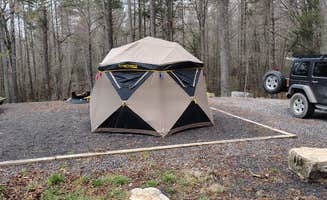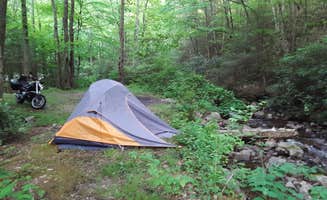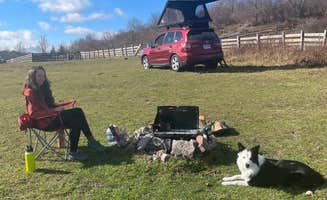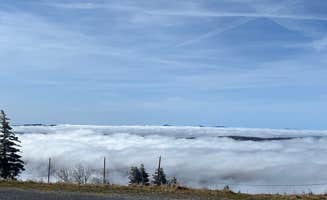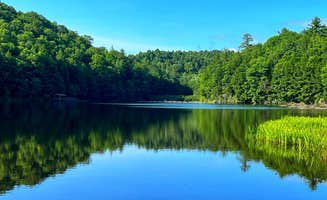Dispersed camping near Woodlawn, Virginia concentrates primarily in the Mount Rogers National Recreation Area and nearby Jefferson National Forest lands. Sites range in elevation from 2,500 to 5,500 feet, with higher elevations experiencing temperatures typically 10-15 degrees cooler than surrounding valleys. Winter camping requires preparation for snow accumulation and ice conditions, particularly at sites above 4,000 feet where road access becomes challenging from November through March.
What to do
Hiking on the Appalachian Trail: Access points near Mount Rogers National Recreation Area provide day hikes or multi-day backpacking options. "We were very lucky to obtain a perfect spot on the top of Mount Roger's during our section hike of the AT. It provided amazing views for both sun up and sun down and was a great place for pictures," notes Lindsay S.
Fishing in local creeks: Fish for trout in streams near Washington & Jefferson National Forest Dispersed Sites where campsites border water access points. "We stayed at this camp for 3 weeks during the pandemic shutdown and it was a perfect place to ride out this crazy storm and decompress from some anxiety," according to one camper who enjoyed the creek-side location.
Wildlife observation: Wild ponies roam throughout the highlands, particularly near established camping areas. "Variety of types of campsites. Amazing sights and wild ponies! The AT provides some great hiking," shares Katie B. about her Mount Rogers experience.
What campers like
Privacy between sites: Walnut Flats offers established dispersed camping with sufficient spacing. "5 sites, stayed in the double site. Quiet place with plenty of firewood on the ground. Occasional people driving through but a great experience!" reports Dennis R.
Night sky viewing: Clear nights at higher elevations provide exceptional astronomy opportunities. "The night sky was one of the most memorable moments from our trip. I've never seen so many stars!" shares a camper about their Mount Rogers experience.
Water proximity: Many dispersed sites position campers near flowing water. "This is a wonderful spot. Free spot, right next to a gorgeous creek. It was totally empty in March - we didn't see a single soul," notes Alexandra T. about Whitetop area camping.
What you should know
Road conditions vary significantly: Access to Scales Trailhead Basecamp requires preparation. "The road in is...'rocky'. High clearance 4wd needed. Not ADV friendly, unless you're very adventurous," warns Jon M. The 45-minute drive from the main road to the campground demands patience and appropriate vehicle capability.
Cell service limitations: Most dispersed sites have no connectivity. "Absolutely no Verizon service," reports one camper at Washington & Jefferson National Forest sites, while another notes at Whitetop, "Very little Verizon and AT&T signal."
Weather extremes: Exposed sites experience significant wind. "THE WIND IS KILLER. We ended up moving our tent to the other side of the car park at the top. There's a nice little piney forest which provided a little shelter from the wind," recounts Whitney B. about camping at Whitetop.
Tips for camping with families
Water filtration required: Bring filtration systems for creek water. "There is no drinking water, picnic tables, or even pit toilet, so come prepared," advises a camper about Washington & Jefferson National Forest sites where creek water requires treatment.
Choose established sites for beginners: Walnut Flats offers amenities suitable for first-time dispersed campers. "This is a wonderful spot. It has five established camp sites with fire rings and picnic tables. The bathroom is a pit style but it was still clean and didn't smell," reports Alice S.
Plan for weather variability: Temperature swings of 30+ degrees between day and night occur regularly, especially at higher elevations. "Only camp here if there's clear skies. Even then, the wind is killer and probably never lets up," cautions a Whitetop camper regarding site selection.
Tips from RVers
Clearance considerations: Most dispersed sites accommodate smaller rigs with adequate ground clearance. "The road to this site is WILD, but doable! I'll leave photos of the worst spots to help you decide whether or not you should drive up to the top. We drove our 2WD Ford Maverick up the rocky road and it handled it just fine," explains Emerald M. about the access to Whitetop Mountain camping.
Level site scarcity: Finding truly level parking for larger rigs requires advance planning. "Nice little free campground with about 5 sites with grill fire rings level gravel drive with tent pad and lantern pole," notes a camper at Walnut Flats, one of the few sites mentioning level parking areas.
Roadside visibility concerns: Consider how close sites position to forest roads. "Overall this was a great little spot right off the road. The sound of the creek was lovely all night. Only downside was the spot I set up camp was very close to the road and headlights from passing cars would light up the spot," shares Erik C. about roadside camping.


